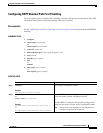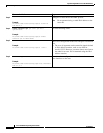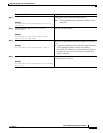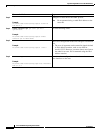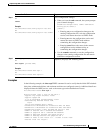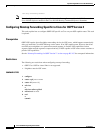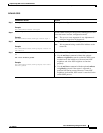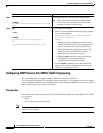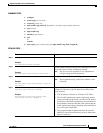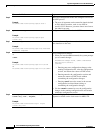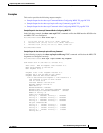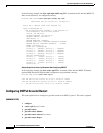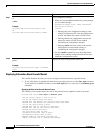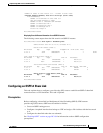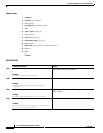
Implementing OSPF on Cisco IOS XR Software
How to Implement OSPF on Cisco IOS XR Software
RC-227
Cisco IOS XR Routing Configuration Guide
OL-14356-01
SUMMARY STEPS
1. configure
2. router ospf process-name
3. router-id {router-id}
4. mpls traffic-eng router-id {ip-address | interface-type interface-instance}
5. area area-id
6. mpls traffic-eng
7. interface type instance
8. end
or
commit
9. show ospf [process-name] [area-id] mpls traffic-eng {link | fragment}
DETAILED STEPS
Command or Action Purpose
Step 1
configure
Example:
RP/0/RP0/CPU0:router# configure
Enters global configuration mode.
Step 2
router ospf process-name
Example:
RP/0/RP0/CPU0:router(config)# router ospf 1
Enables OSPF routing for the specified routing process and
places the router in router configuration mode.
Note The process-name argument is any alphanumeric
string no longer than 40 characters.
Step 3
router-id {router-id}
Example:
RP/0/RP0/CPU0:router(config-ospf)# router-id
192.168.4.3
Configures a router ID for the OSPF process.
Note We recommend using a stable IPv4 address as the
router ID.
Step 4
mpls traffic-eng router-id {ip-address |
interface-type interface-instance}
Example:
RP/0/RP0/CPU0:router(config-ospf)# mpls
traffic-eng router-id loopback 0
(Optional) Specifies that the traffic engineering router
identifier for the node is the IP address associated with a
given interface.
• This IP address is flooded to all nodes in TE LSAs.
• For all traffic engineering tunnels originating at other
nodes and ending at this node, you must set the tunnel
destination to the traffic engineering router identifier of
the destination node because that is the address that the
traffic engineering topology database at the tunnel head
uses for its path calculation.
• We recommend that loopback interfaces be used for
MPLS TE router ID because they are more stable than
physical interfaces.



